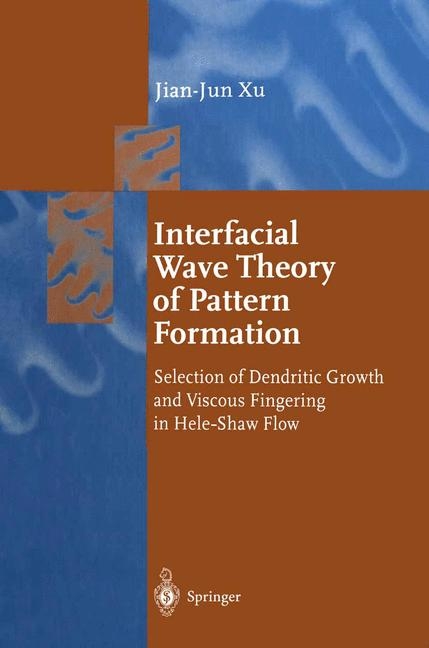
Interfacial Wave Theory of Pattern Formation
Springer Berlin (Verlag)
978-3-642-80437-3 (ISBN)
- Titel erscheint in neuer Auflage
- Artikel merken
1. Introduction.- 1.1 Interfacial Pattern Formations in Dendrite Growth and Hele-Shaw Flow.- 1.2 A Brief Review of the Theories of Free Dendrite Growth.- 1.2.1 Maximum Velocity Principle (1976).- 1.2.2 Marginal Stability Hypothesis (1978).- 1.2.3 Microscopic Solvability Condition (MSC) Theory (1986-1990s).- 1.2.4 Interfacial Wave (IFW) Theory (1990).- 1.3 Macroscopic Continuum Model.- 1.3.1 Macroscopic Transport Equations.- 1.3.2 The Interface Conditions.- 1.3.3 The Scaling and the Dimensionless System.- References.- 2. Unidirectional Solidification and the Mullins-Sekerka Instability.- 2.1 Solidification with Planar Interface from a Pure Melt.- 2.1.1 Basic Steady State Solution.- 2.1.2 Unsteady Perturbed Solutions and Mullins-Sekerka Instability.- 2.1.3 Asymptotic Solutions in the Long-Wavelength Regime, k = O(?).- 2.1.4 Asymptotic Solutions in the Extremely Short-Wavelength Regime, k = O (1/ ?).- 2.2 Unidirectional Solidification from a Binary Mixture.- 2.2.1 Mathematical Formulation of the Problem.- 2.2.2 Basic Steady State.- 2.2.3 Unsteady Perturbed Solutions.- 2.2.4 Asymptotic Solutions in the Long-Wavelength Regime, k = O(?).- 2.2.5 Asymptotic Solutions in the Extremely Short-Wavelength Regime, k = O(1/ ?); g = O1/ ?).- 2.2.6 Some Remarks on Unidirectional Solidification.- References.- 3. Mathematical Formulation of Free Dendrite Growth from a Pure Melt.- 3.1 Three-Dimensional Axially Symmetric Free Dendrite Growth.- 3.2 Two-Dimensional Free Dendrite Growth.- Reference.- 4. Steady State of Dendrite Growth with Zero Surface Tension and Its Regular Perturbation Expansion.- 4.1 The Ivantsov Solution and Unsolved Fundamental Problems..- 4.2 Three-Dimensional Axially Symmetric Steady Needle Growth.- 4.2.1 Mathematical Formulation.- 4.2.2 The Regular Perturbation Expansion Solutions (RPE) as ?? 0.- 4.2.3 The Asymptotic Behavior of the Regular Perturbation Expansion Solution as ? —> ?.- 4.3 Two-Dimensional, Steady Needle Crystal Growth.- 4.3.1 Mathematical Formulation of Two-Dimensional Needle Growth.- 4.3.2 The Regular Perturbation Expansion Solution as ? —> 0.- 4.3.3 Asymptotic Behavior of the Regular Perturbation Expansion Solution as ? —> ?.- 4.4 Summary and Discussion.- References.- 5. The Steady State for Dendrite Growth with Nonzero Surface Tension.- 5.1 The Nash-Glicksman Problem and the Classic Needle Crystal Solution.- 5.2 The Geometric Model and Solutions of the Needle Crystal Formation Problem.- 5.2.1 Geometric Model of Dendrite Growth.- 5.2.2 The Segur-Kruskal Problem.- 5.2.3 Nonclassic Steady Needle Growth Problem.- 5.2.4 Needle Crystal Formation Problem.- 5.3 The Nonclassic Steady State of Dendritic Growth with Nonzero Surface Tension.- 5.3.1 The Complete Mathematical Formulation for Free Dendrite Growth.- References.- 6. Global Interfacial Wave Instability of Dendrite Growth from a Pure Melt.- 6.1 Linear Perturbed System Around the Basic State of Three-Dimensional Dendrite Growth.- 6.2 Outer Solution in the Outer Region away from the Tip.- 6.2.1 Zeroth-Order Approximation.- 6.2.2 First-Order Approximation.- 6.2.3 Singular Point ?cof the Outer Solution.- 6.3 The Inner Solutions near the Singular Point ?c.- 6.4 Tip Inner Solution in the Tip Region.- 6.5 Global Trapped-Wave Modes and the Quantization Condition.- 6.6 Global Interfacial Wave Instability of Two-Dimensional Dendrite Growth.- 6.7 The Comparison of Theoretical Predictions with Experimental Data.- References.- 7. The Effect of Surface Tension Anisotropy and Low-Frequency Instability on Dendrite Growth.- 7.1 Linear Perturbed System Around the Basic State.- 7.2 Multiple Variable Expansion Solution in the Outer Region.- 7.3 The Inner Equation near the Singular Point ?c.- 7.3.1 Case I: ?0= O(l).- 7.3.2 Case II: |?0| ? 1.- 7.3.3 A Brief Summary.- 7.4 Matching Conditions.- 7.5 The Spectra of Eigenvalues and Instability Mechanisms.- 7.5.1 The Global Trapped-Wave Instability.- 7.5.2 The Low-Frequency Instability.- 7.6 Low-Frequency Instability for Axially Symmetric Dendrite Growth.- 7.7 The Selection Conditions for Dendrite Growth.- References.- 8. Three-Dimensional Dendrite Growth from Binary Mixtures.- 8.1 Mathematical Formulation of the Problem.- 8.2 Basic State Solution for the Case of Zero Surface Tension.- 8.3 Linear Perturbed System for the Case of Nonzero Surface Tension.- 8.4 The MVE Solutions in the Outer Region.- 8.4.1 The Zeroth-Order Approximation.- 8.4.2 The First-Order Approximation.- 8.5 The Inner Solutions near the Singular Point ?c.- 8.6 Global Modes and the Quantization Condition.- 8.7 Comparisons of Theoretical Results with Experimental Data.- References.- 9. Viscous Fingering in a Hele-Shaw Cell.- 9.1 Introduction.- 9.2 Mathematical Formulation of the Problem.- 9.3 The Smooth Finger Solution with Zero Surface Tension.- 9.4 Formulation of the General Problem in Curvilinear Coordinates (?,?)and the Basic State Solutions.- 9.5 The Linear Perturbed System and the Outer Solutions.- 9.6 The Inner Equation near the Singular Point ?c.- 9.6.1 Case I: |?0| = O(1).- 9.6.2 Case II: |?0| ?1.- 9.7 Eigenvalues Spectra and Instability Mechanisms.- 9.7.1 The Spectrum of Complex Eigenvalues and GTW Instability.- 9.7.2 The Spectrum of Real Eigenvalues and the LF Instability.- 9.8 Fingering Flow with a Nose Bubble.- 9.8.1 The Basic State of Finger Formation with a Nose Bubble and Its Linear Perturbation.- 9.8.2 The Quantization Conditions for the System with a Nose Bubble.- 9.9 The Selection Criteria of Finger Solutions.- References.
| Reihe/Serie | Springer Series in Synergetics ; 68 |
|---|---|
| Zusatzinfo | XII, 296 p. |
| Verlagsort | Berlin |
| Sprache | englisch |
| Maße | 155 x 235 mm |
| Gewicht | 475 g |
| Themenwelt | Naturwissenschaften ► Physik / Astronomie ► Allgemeines / Lexika |
| Schlagworte | Condensed Matter • Condensed matter physics • Crystal • curvilinear coordinates • Dendrite Growth • eigenvalue • Equilibrium • fluid mechanics • interfacial instability • Mechanics • pattern formation • Quantization • Solution • viscous fingering |
| ISBN-10 | 3-642-80437-3 / 3642804373 |
| ISBN-13 | 978-3-642-80437-3 / 9783642804373 |
| Zustand | Neuware |
| Informationen gemäß Produktsicherheitsverordnung (GPSR) | |
| Haben Sie eine Frage zum Produkt? |
aus dem Bereich


